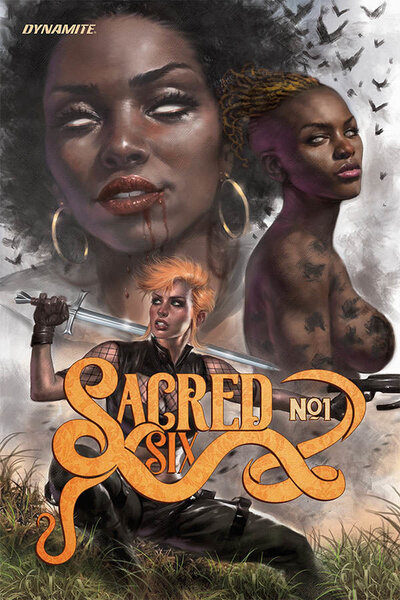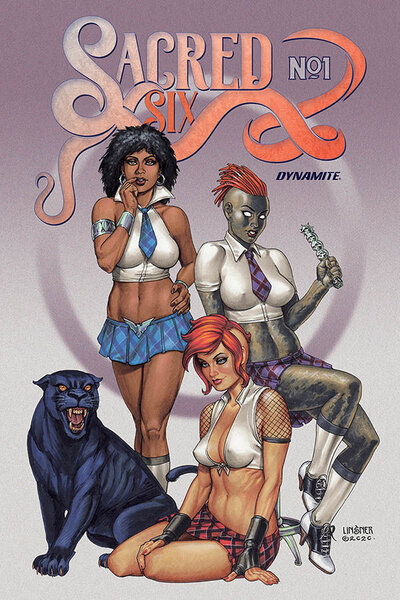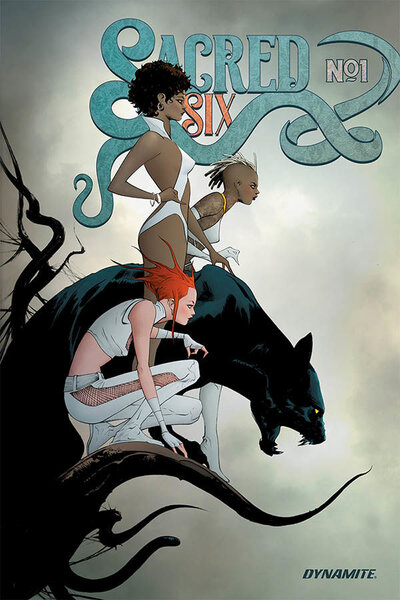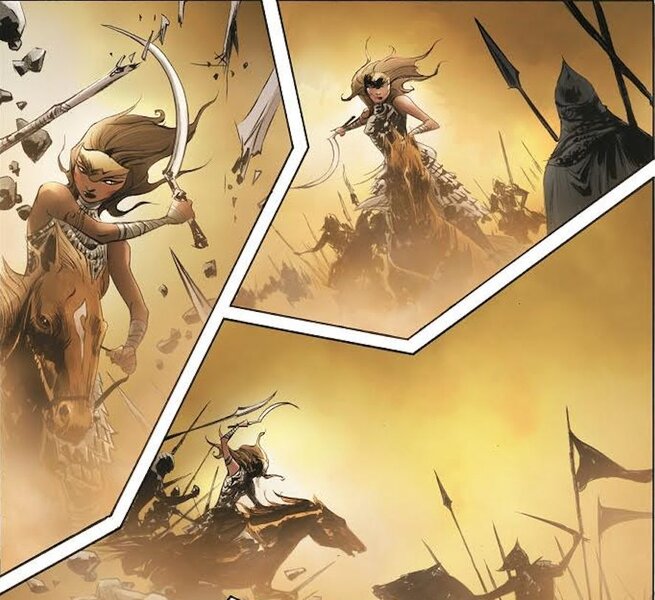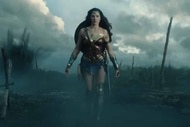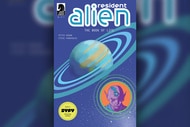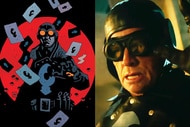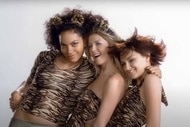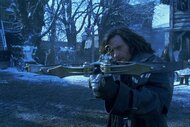Create a free profile to get unlimited access to exclusive videos, sweepstakes, and more!
Christopher Priest took inspiration from Westworld & Wizard of Oz for Vampirella spin-off Sacred Six
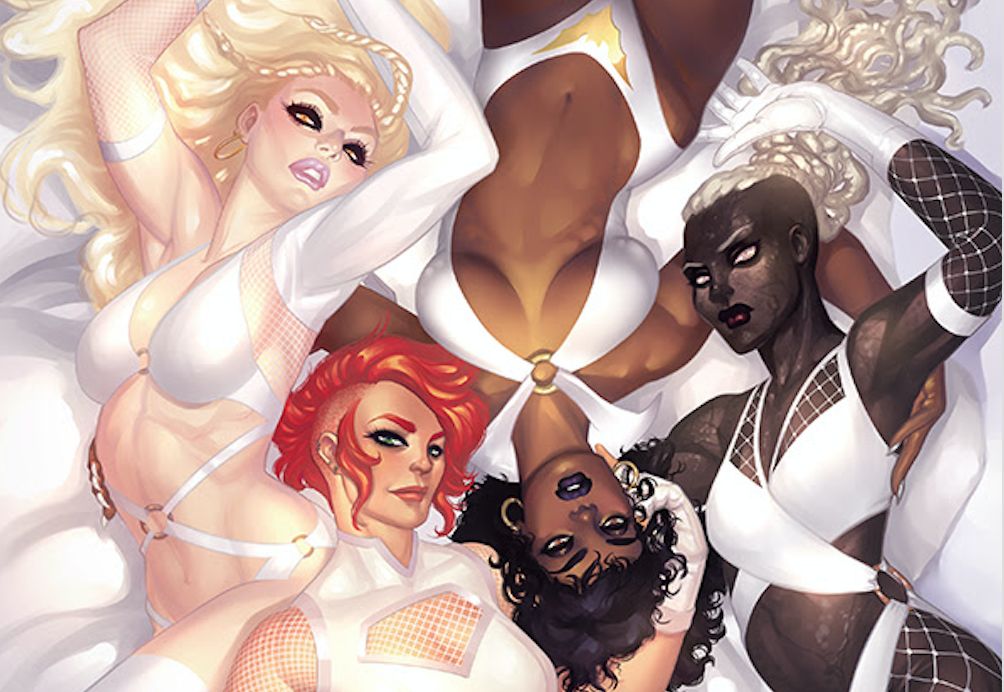
Christopher Priest holds a special place in comics history as the first full-time African American writer/editor to emerge in the industry when he was hired by Marvel Comics back in 1979.
Priest got his start writing the 1983 The Falcon miniseries before getting promoted to a prominent writing position that led to jobs on Power Man and Iron Fist, Conan The Barbarian, and The Amazing Spider-Man. He then moved to DC for a spell, penning titles like Green Lantern, The Ray, Hawkman, Deathstroke, and Steel. Perhaps his greatest original creation is Valiant's Quantum and Woody, billed as The World's Worst Superhero Team, which Priest co-created with artist M.D. Bright.
But it was Priest’s defining run on Black Panther from 1998-2003 that cemented his prominence, especially when Marvel mined several plot elements from that series to serve as the foundation for the MCU's Black Panther movie. More recently, Priest launched into a tumultuous 10-issue arc for DC's Justice League in 2017 right before Scott Snyder took over in 2018.
Now Priest is back with Sacred Six, a new Vampirella spin-off series for Dynamite, which delves into the mythology and expanded universe of Vampi with artists Gabriel Ibarra and Jae Lee. The New York City-born writer is intimately familiar with the bloodsucker from Drakulon as the head writer for Dynamite's ongoing Vampi series that arrived last year.
Arriving on May 27, Sacred Six finds four lethal women lured to rural Georgia as part of a mysterious scheme to defend an impoverished farming town under siege by zealots. But these aren't four ordinary women. Draculina, Pantha, Nyx, and Chastity have been brought together in Ashthorne in an effort to avert all-out war against nearby Sacred, Georgia. But Ashthorne shelters a horrid secret and lurking in the shadows is the sorceress Lilith, mother of Vampirella.
SYFY WIRE chatted with Priest about this bloody project to learn what attracted him to the horror realm, the rewards of working with Ibarra and Lee, and what readers can expect when these four killers defend the troubled town of Sacred.
At this point in your distinguished career, why is this project something that delivers a fresh challenge?
[Laughs.] OK, if you want to call 40 years of hanging on by your fingernails “distinguished!”
Here’s what I like about Dynamite: They tend to give me all the rope I need to hang myself.
I tend to work within realism, injecting as much reality as is available into our larger-than-life tales. As I’ve said many times, writing is a search for the truth; a struggle to reveal something that is true, something that is relevant. My goal is to make you laugh, make you cry, make you think. A preacher is in the business of changing peoples’ minds, of creating a rhetorical argument for change.
My Vampirella plans initially elicited quite a bit of pushback from the bosses who were concerned about the book becoming too issue-focused or even too political. Over time, the negotiated execution of those plans have proved to be less incendiary than feared, and the book has, I’m happy and relieved to say, found an audience.
Were there specific themes in the mythos you wished to explore?
This book employs very thinly veiled metaphors of ghouls and goblins, but it’s about us — all of us. White, black, straight, LGBTQ+, Muslim, Christian, Jew, Hindu. About our individual right to breathe air and simply to be. Our planet has become a very strange place where simple acceptance is routinely threatened by all the yelling and finger-pointing and the endless yapping on social media and cable news.
The theme of Vampirella is acceptance. She is a stranger marooned here who desires the same things we all do — love, life, community. But she is constantly denied these things on account of her being different and the biases people make based on those differences. This is a universal theme applicable to many different segments of our population.
We’d planned to expand these themes into questions of civil rights. Yes, civil rights for vampires and ghouls. Do the undead actually have rights? Who gets to decide?
When Dynamite chose to expand our little Vampirella experiment, we took elements of our original plans and developed the new book around them, which now allows the Vampirella book to pursue other storylines in year two.
What sort of dynamics and conflicts can fans expect from this motley crew of killers?
Well, it’s The Wizard of Oz. This one wants to get home. This one wants a heart. This one wants a brain. And then there’s Toto, or, in this case, Pantha.
The first arc is, aptly, the story of how and why these ladies form a team. They don’t bump into each other at the mall in Issue #1 and gavel in their first meeting. Each of these women represents a fully realized character with dimension and depth, passion, fears, and personal struggles. They arrive at Ashthorne, a dead-end town south of Atlanta, Georgia, via individual and seemingly unrelated paths.
What was the plan to inject new blood into these characters in your signature style?
That suggests I have a plan! [Laughs.] What I do have is the support of the company and my editor to explore the characters and take a fresh swing at them. Jae Lee will be telling the story of Pantha, which will be an amalgam of several tweaked versions of her origin. Gabriel Ibarra is the new guy who has an exciting yet creepy Sienkiewicz-Wrightson blend and who really knows how to work those shadows and hard lighting.
I’m pretty sure I’ve been infected by Netflix and HBO, whose presentations of things like Daredevil and Westworld have demonstrated ways to smartly contemporize old favorites. My goal is to keep the characters true, as I tried to do with Deathstroke, while adding a dimension not quite seen before or exploring an aspect that was always there but not focused upon.
And humor. I think humor is extremely important and often missing from a lot of what we do. The humor in the Star Wars or MCU Universes is like rocket fuel for those franchises.
How has working on Dynamite’s main Vampi series energized your output and elicited excitement for this new spin-off miniseries?
Well, that’s likely because of publisher Nick Barrucci. See, working within a strict continuity at the majors brings a lot of restrictions along with it. I kept expecting Nick or Executive Editor Joe Rybandt to beat me with a golf club, especially with my injecting a sardonic psychotherapist into the mix who mocks literally everything Dynamite represents.
I’m reminded that the funniest David Letterman ever was when he was feuding with his NBC bosses. “If those guys had any sense of humor at all,” I recall Letterman saying on-air, “they’d come downstairs right now and fire me.” Hilarious.
Doc Chary, Vampirella’s analyst, mocks the whole notion of the supernatural. This is the essence of much of my writing and, I’ve been told, why I am not a top writer in the biz. The voice of my writing tends to kick the shins of most superhero comic book norms in much the same way that Jerry Seinfeld points out life’s little absurdities. Doc Chary is Everett K. Ross is Woody is Natasha Irons is Luke Cage from my old Power Man and Iron Fist run.
So I’m like a dog off his leash, racing around the neighborhood, yapping. I’m having so much fun, loving every minute of working on Vampirella.
Artist Ergün Gündüz gets better with every issue, offering up new surprises and incredible moments that cause Editor Matt Idelson and me to literally stop and gawk. I was an intern at Marvel when Walt Simonson pages or Gene Colan pages would arrive in FedEx. I mean, people would stop what they were doing and gather around me at the copy machine to gawk.
How was this gig different from your work on Quantum & Woody, Black Panther, or Justice League?
It’s very similar to working with Fabian Nicieza on Quantum & Woody. Having been a freelancer most of his career, Fabian made possibly the best boss I ever worked for. He is a creative person and he understands creative talent and how nutty and insecure we all are.
Joe Quesada and Jimmy Palmiotti were similarly equipped to handle Marvel Knights, the imprint that relaunched Black Panther. People who have worked on the talent/supplier side of the desk usually make better ship captains than those who lack that experience, and it really shows in the work. Marvel Knights was dynamic and energized every character in the imprint because it was a sub-imprint of Marvel run by the creators themselves.
Justice League was an incredible struggle. The editor and I had this wacky idea of injecting a heavy dose of realism, of taking a hard look at the whole idea of a group of people with god-like powers who answer to no one and live on a satellite with the ability to instantly teleport anywhere in the world. Now, if that existed in our actual world, there’d be paranoia and apprehension and Senate hearing after Senate hearing.
My favorite part was the team turning on Batman. I’m sick of Batman leading the Justice League. It was, initially, a brilliant Keith Giffen idea that’s just worn out its welcome. And, at the time, Batman was in, I think, 632 monthly titles. In my realistic space, such a person was bound to make a mistake. And he did, which was the inciting incident for the entire story arc: a sleep-deprived Bats makes a simple mistake [in Issue #34] that ultimately divides the team. Shameless plug, my entire Justice League run is available in trade and hardcover editions.
The idea was to locate various points of conflict within the group, apply pressure, and see what happens. This is precisely the template for Sacred Six.
I detected some classic film influences injected into Sacred Six. Were there any movies that inspired your take?
Oh, heck. Take your pick of most any submarine movie — a group of people in a confined space under extreme pressure. Beyond that, I’m still struggling to present authentic horror. Gabriel Ibarra’s art is so pretty I’m scared of having it colored. Horror just looks better in black and white to me, and Ibarra is a real master of shadow and light.
Tod Browning and Karl Freund’s 1931 classic starring Bela Lugosi [Dracula] comes immediately to mind: low budget, high suspense. Francis Ford Coppola’s Dracula homage is excellent, as well.
What are your favorite elements of vampire mythology and why do bloodsucker stories resonate and endure?
As a kid, I used to watch vampire movies all the time, mostly the old Hammer films with Christopher Lee. Mom gave us a dollar each and my sister and I would sit in Lowe’s Valencia, a historic theater on Jamaica Avenue in Queens, New York, literally all day watching a double feature at least twice while sitting nearly in the first row. There’s just so much fun in being terrorized. Vampires are simply another flavor of superhero — people who look like us but who have vast powers we all wish we had.
During the '80s, Frank Langella and others birthed the now-common romantic vampire idea and teen-angst vampire genre, which I never got into. The challenge in comics is there’s no music. No sound. It is tough to pace the story or enforce the pace of the story because the end-user, the reader, is in control of how fast they flip the pages. I have never read a comic book, ever, that frightened me. Not even once.
Coppola’s Dracula, on the other hand, is a film I refuse to watch at night. I’m serious. The sound mix has creepy whispers mixed into the surrounds that I keep forgetting about, and they startle me every time, making me believe someone’s in the house with me.
As a veteran of the comics industry, where do you see the business as it emerges from the current global pandemic and forges ahead?
For a long time, I have been concerned about Diamond’s monopoly on comics distribution. Not that Diamond is bad, but that the industry is too small. Despite the unparalleled success of blockbuster films, the print comics medium remains a fairly small and fragile industry.
As corny as it sounds, I do believe in America and in America’s ability to reinvent itself, learn, grow, and come back stronger. I don’t know where I’ll be in six months or if I’ll have a job or a house or a dog. OK, maybe the dog.
The institutional weaknesses within the comics industry business model have been there a long time. The frustrating challenge to make digital as profitable as print — again I bow to Netflix — is a challenge the industry really has to find some way to rise to. If digital were as profitable as print, this would or at least could be a boon season for the industry. Streaming networks are straining under the network traffic but our friends the retailers are suffering.
I’m confident there will be comic books because people still want comic books. That’s why we haven’t been able to make digital as profitable as it needs to be. But I think the current model’s vulnerability brought the business to a shuddering halt.
So I have to believe fixing that, or at least addressing it in some concrete way, is now the high priority it should have been all along.
